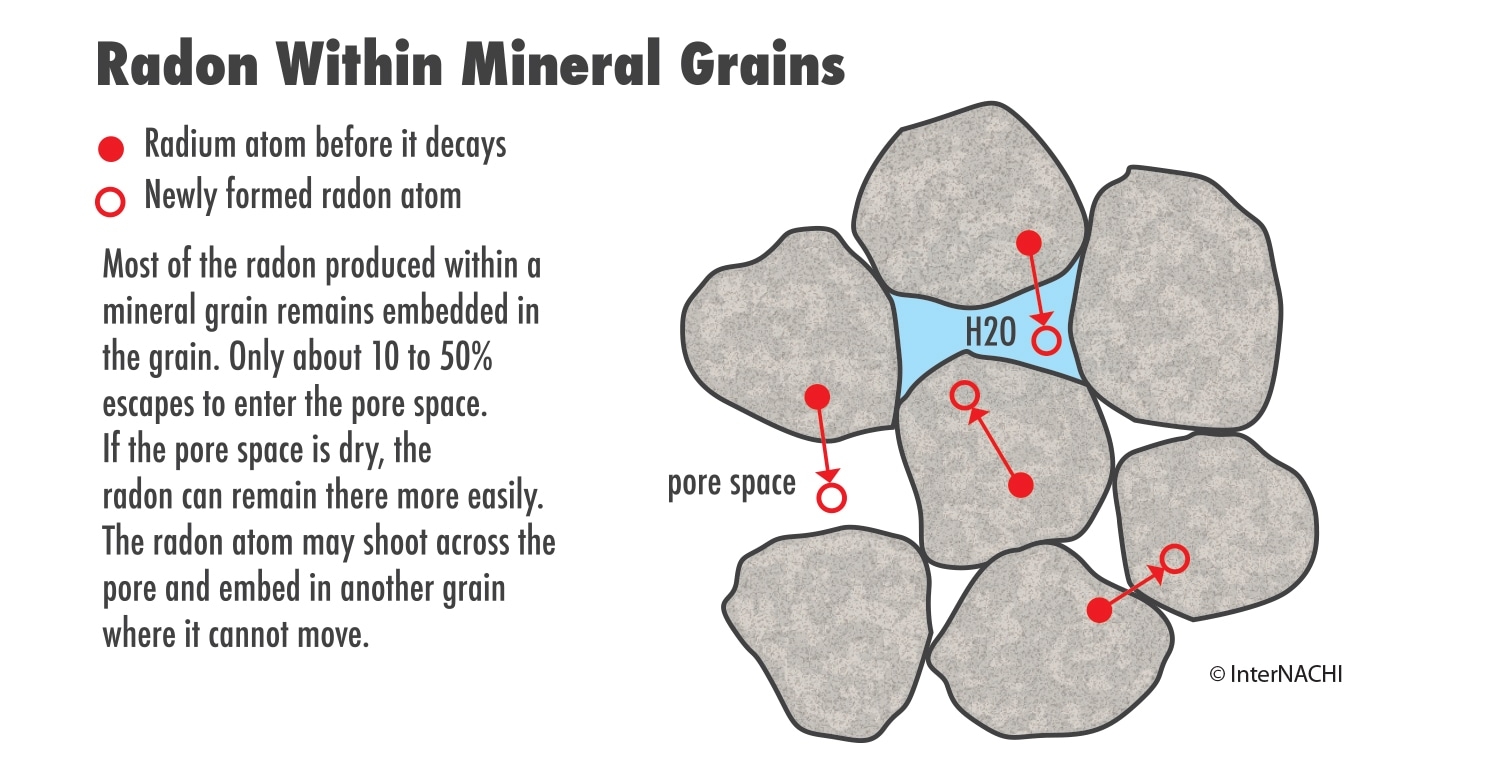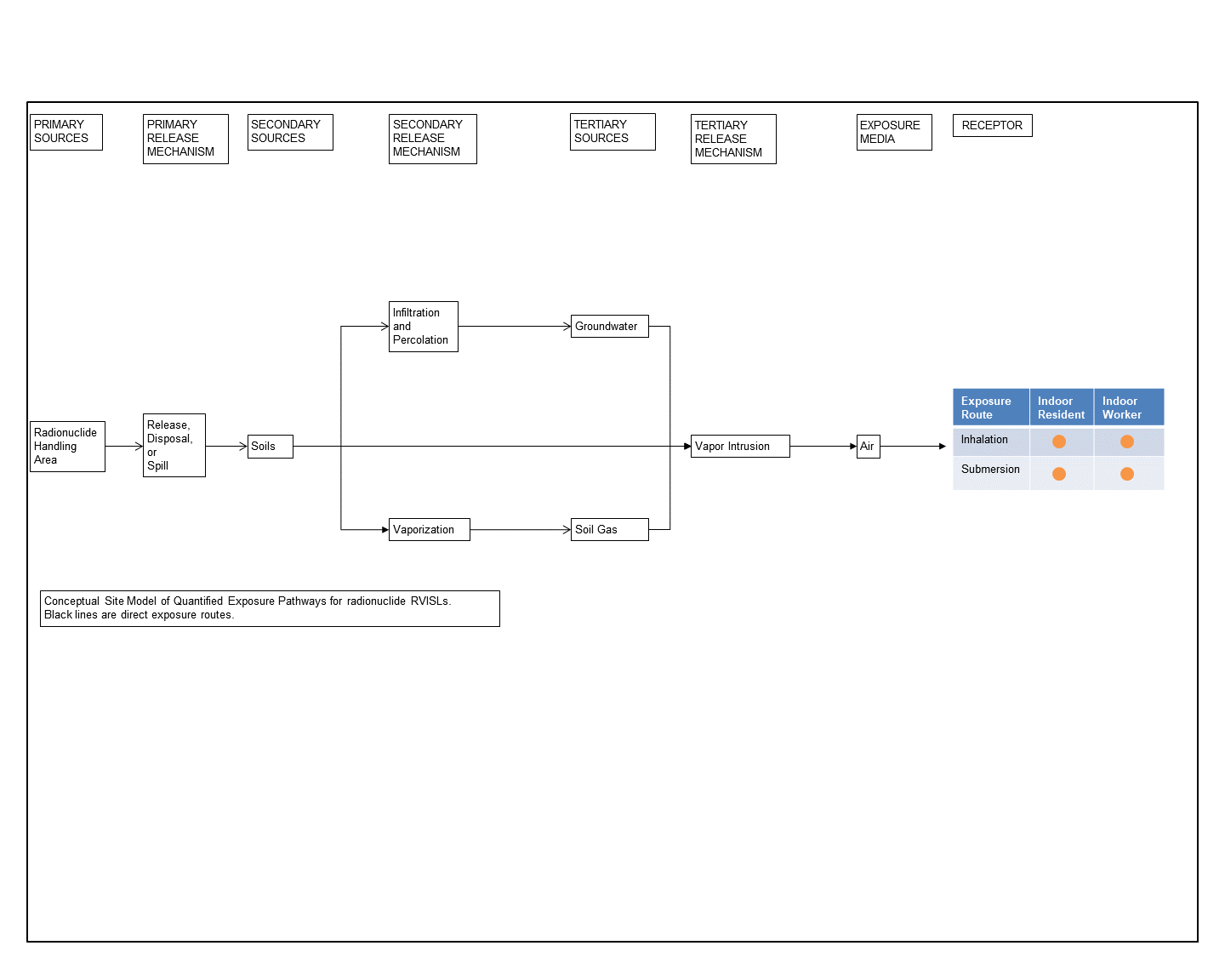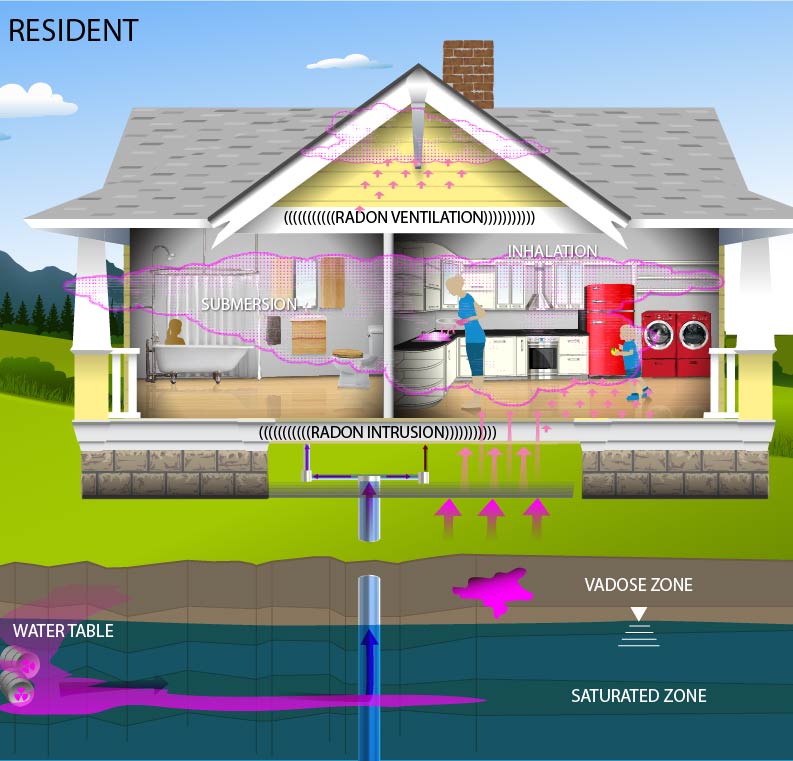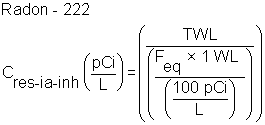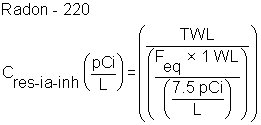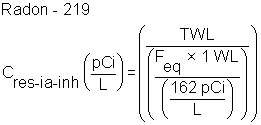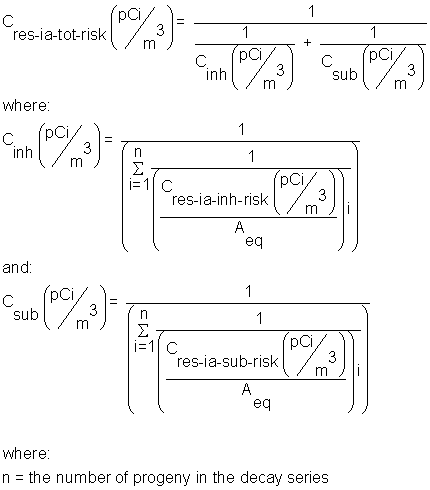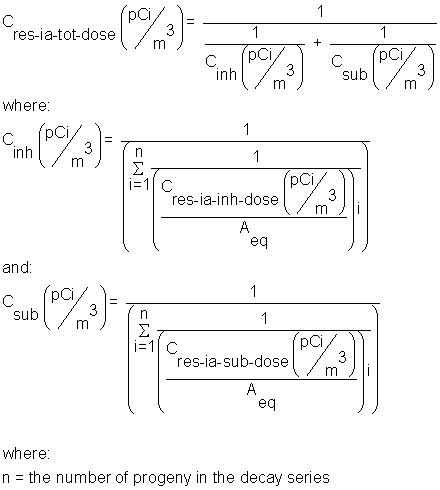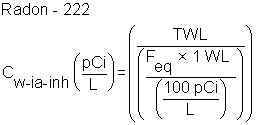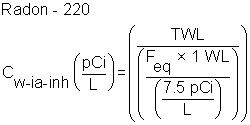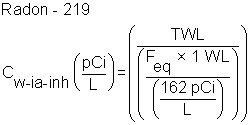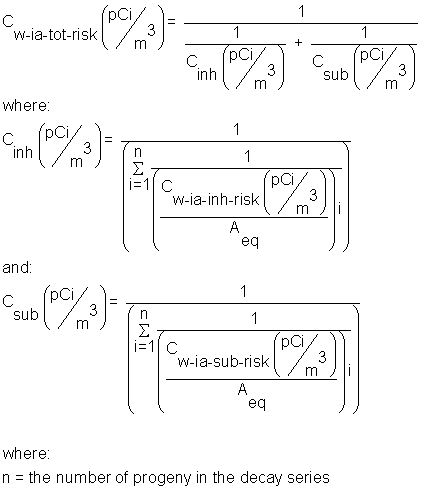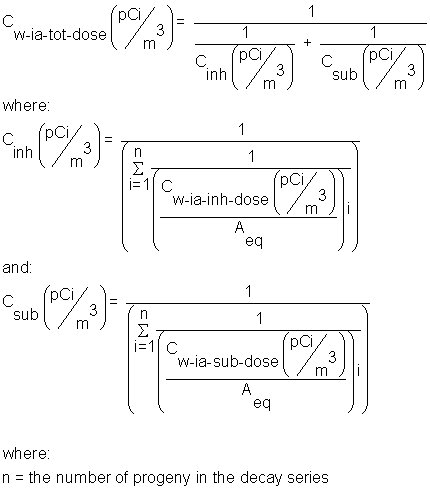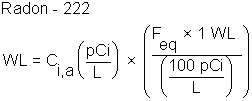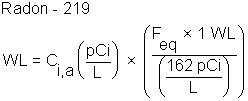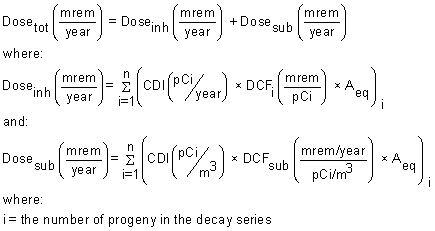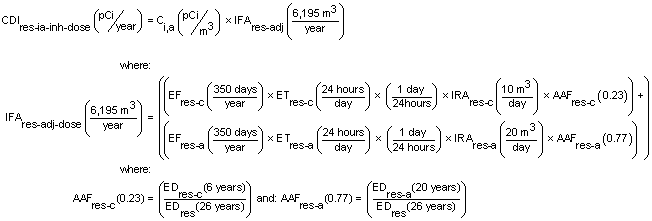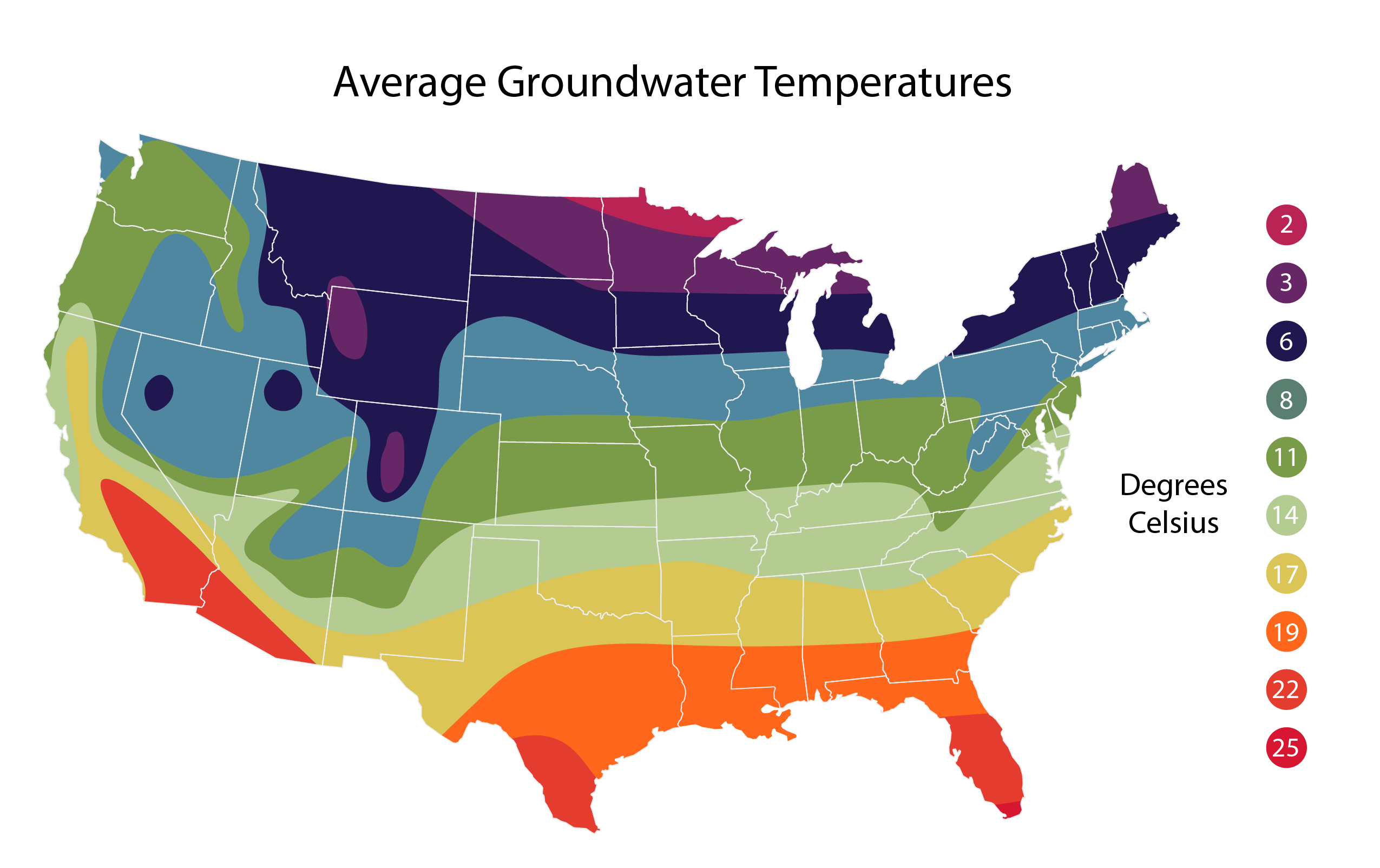page title goes here Risk Assessment
RVISL User's Guide
Radon Vapor
Intrusion
Screening Levels
(RVISLs)
Welcome to the EPA's Radon Vapor Intrusion Screening Level (RVISL) Calculator User's Guide for Radionuclide Contaminants at Superfund Sites. This guide contains descriptions, equations, and default exposure parameters used to calculate cancer risk and dose-based RVISLs. Additional guidance is also provided on sources of parameters and proper RVISL use. It is suggested that users read the RVISL Frequent Questions page before proceeding. The User's Guide is extensive, so please use the "Open All Sections" and "Close All Sections" links below as needed. Individual sections can be opened and closed by clicking on the section titles. Before proceeding through the User's Guide, please read the Disclaimer below.
This tool provides screening level (SL) concentrations of radon (Rn) for groundwater, soil gas (sub-slab and exterior), and indoor air to assist Agency staff with making a RVISL determination based on limited, initial data. In addition to calculating SLs, this tool can calculate indoor air concentrations from radon in soil gas and groundwater concentrations entered by the user. The cancer risk and dose from calculated indoor air concentrations and user-provided indoor air concentrations can also be calculated. The equations for these features are presented in the following sections. For Comprehensive Environmental Response, Compensation, and Liability Act (CERCLA) remedial actions, dose assessment is generally done only to show compliance with a dose-based Applicable or Relevant and Appropriate Requirement (ARAR). In addition, the calculator presents the option to compare the indoor air concentration, entered by the user or derived from groundwater or soil gas activities, to state standards or Uranium Mill Tailings Radiation Control Act (UMTRCA) standards, which also may be potential ARARs. For more information on when UMTRCA indoor radon standards are potential ARARs, see the guidance document "Establishment of Cleanup Levels for CERCLA Sites with Radioactive Contamination" Attachment A: Likely Federal Radiation (AEA, UMTRCA, CAA, CWA, SDWA) ARARs, page 3 (OSWER Directive 9200.4-18, August 1997). Users should note that since background radon levels are typically outside the risk range, the RVISL calculator is likely to be used primarily for ARAR compliance. For example, the UMTRCA indoor radon standards 40 CFR 192.12(b)(1) and 192.41(b) were identified as likely Federal ARARs for Rn-222 and Rn-220 in Attachment A of the EPA guidance document "Establishment of Cleanup Levels for CERCLA Sites with Radioactive Contamination." There are some state standards expressed in pCi/l or mrem/yr that, if more stringent than the UMTRCA standards, may be selected as ARARs.
RVISLs are a type of preliminary remediation goal (PRG) and both are a specific variety of the broad SL category. The RVISL calculator provides updated guidance for developing SLs), for indoor Rn-222, Rn-220, and Rn-219 that are risk- or dose-based and for showing compliance with the UMTRCA indoor radon standards for Rn-222 and Rn-220. The RVISL, therefore, supersedes the risk assessment approach in Preliminary Remediation Goals for Radionuclides in Buildings (BPRG) electronic calculator, the dose assessment approach in ARAR Dose Compliance Concentrations Goals for Radionuclides in Buildings (BDCC) electronic calculator, and Q17 of the guidance document "Radiation Risk Assessment At CERCLA Sites: Q & A" issued on May 2014. Computer codes such as the RVISL, which were developed to predict hazards from potential human exposure to radon concentrations in indoor air, are based on simplified equations and protective assumptions. While RVISLs may be imprecise for an individual house or structure they are protective in nature for screening a wide variety of buildings. EPA would recommend, where possible, Regions use measurements of radon indoors rather than rely on the transport portions of the RVISL. In particular, testing of groundwater or soil gas is not required to demonstrate compliance with RVISL WL, pCi/L, risk, or dose targets.
Open All Sections | Close All SectionsDisclaimer
This guidance sets forth a recommended, but not mandatory, approach based upon currently available information with respect to risk and dose assessment for response actions at CERCLA sites. This document does not establish binding rules. Alternative approaches for risk assessment may be found to be more appropriate at specific sites (e.g., where site circumstances do not match the underlying assumptions, conditions, and models of the guidance). The decision whether to use an alternative approach and a description of any such approach should be documented for such sites. Accordingly, comments questioning the use of the approaches recommended in this guidance at individual CERCLA sites should be considered and an explanation provided for the selected approach.
It should also be noted that the RVISLs produced by this calculator are based upon human health risk and do not address potential ecological risk. Some sites in sensitive ecological settings may also need to be evaluated for potential ecological risk. EPA's guidance "Ecological Risk Assessment Guidance for Superfund: Process for Designing and Conducting Ecological Risk Assessment" contains an eight-step process for using benchmarks for ecological effects in the remedy selection process.
The RVISL calculator provides updated guidance for developing SLs or PRGs for indoor Rn-222, Rn-220, and Rn-219 that are risk- or dose-based and for showing compliance with the UMTRCA indoor radon standards for Rn-222 and Rn-220. The RVISL calculator appraoch, therefore, supersedes the risk assessment approach in Preliminary Remediation Goals for Radionuclides in Buildings (BPRG) electronic calculator, the dose assessment approach in ARAR Dose Compliance Concentrations Goals for Radionuclides in Buildings (BDCC) electronic calculator, and Q17 of the guidance document "Radiation Risk Assessment At CERCLA Sites: Q & A" issued on May 2014.
1. Introduction
A purpose of this guidance is to provide a RVISL calculation tool to assist risk assessors, remedial project managers, on-scene coordinators, and others involved with risk assessment and decision-making at CERCLA sites in developing RVISLs. This RVISL calculator is based on the Technical Guide for Assessing and Mitigating the Vapor Intrusion Pathway from Subsurface Vapor Sources to Indoor Air (June 2015) which provides guidance on calculating risk-based VISLs with adaptations specifically for radon. Initially used at the scoping phase of a project using readily available information, risk-based RVISLs may be modified based on site-specific data gathered during the RI/FS study. RVISL development and screening should assist staff in streamlining the consideration of remedial alternatives. Radionuclide-specific RVISLs are from two general sources. These are: (1) concentrations based on potential Applicable or Relevant and Appropriate Requirements (ARARs) and (2) risk-based concentrations. ARARs include concentration limits set by other environmental regulations, such as Safe Drinking Water Act maximum contaminant levels (MCLs). The second source for RVISLs, and the focus of this database tool, is risk-based calculations that set concentration limits using carcinogenic toxicity values under specific exposure conditions.
The recommended approach for developing remediation goals is to identify RVISLs at scoping, modify them as needed at the end of the RI or during the FS based on site-specific information from the baseline risk assessment, and ultimately select remediation levels in the Record of Decision (ROD). In order to set radionuclide-specific RVISLs in a site-specific context, however, assessors must answer fundamental questions about the site. Information on the radionuclides that are present onsite, the specific contaminated media, land-use assumptions, and the exposure assumptions behind pathways of individual exposure is necessary in order to develop radionuclide-specific RVISLs. The RVISL calculator provides the ability to modify the standard default PRG exposure parameters to calculate site-specific RVISLs.
This database tool presents standardized risk- and dose-based RVISLs and variable risk-based RVISL calculation equations for radioactive contaminants. Ecological effects are not considered in the calculator for radionuclide RVISLs.
RVISLs are presented for indoor residents and workers for air, groundwater, and sub-slab soil gas. The primary RVISLs are based on the carcinogenicity of radon and short-lived progeny. Secondary RVISLs may be calulated based on dose or working levels (WLs). Cancer slope factors (SFs) and dose coefficients (DCFs) used are provided by the Center for Radiation Protection Knowledge. The main report is Calculations of Slope Factors and Dose Coefficients, and the tables of slope factors are in a separate appendix. Inhalation risk and dose coefficients are provided in a more recent report, Radon Cancer Risk Coefficients & Age-Specific Effective Dose Coefficients..
Non-carcinogenic effects are not considered for radon.
The standardized RVISLs are based on default exposure parameters and incorporate exposure factors that present RME conditions. Once this database tool is used to retrieve standard RVISLs or calculate site-specific RVISLs, it is important to clearly demonstrate the equations and exposure parameters used in the calculations. Discussion of the assumptions that go into the calculated RVISLs should be included in the document where the RVISLs are presented, such as a Remedial Investigation (RI) Report or Feasibility Study (FS).
This website combines current Center for Radiation Protection Knowledge SFs and DCFs with standard exposure factors to estimate contaminant concentrations in environmental media (air, sub-slab soil gas, and groundwater) that are protective of humans (including sensitive groups) over a lifetime. Sufficient knowledge about a given site may warrant the use of site-specific assumptions, which may differ from the defaults. Exceeding a RVISL usually suggests that further evaluation of the potential risks is appropriate. The RVISL concentrations presented on this website can be used to screen pollutants in environmental media, trigger further investigation, and provide initial cleanup goals, if applicable. RVISLs should be applied in accordance with guidance from EPA Regions.
In addition to this guidance, for relevant training, see the internet-based course "Radiation Risk Assessment: Updates and Tools."
2. Understanding the RVISL Website
This section presents discussion of the many underlying assumptions in calculaton of a RVISL. Introductions to the concepts of risk, dose, and working level (WL) calculations are presented. Radon-specific parameters and isotope-specific toxicity values are discussed. Discussions of model limitations are also presented.
2.1 General Considerations
Radon is an inert, cancer-causing, radioactive gas at room temperature, and the following criteria used to determine if a chemical is suitable for vapor intrusion analysis will be ignored for this calculator.
- To determine vapor intrusion of a chemical, the chemical must first meet the criteria for volatility, which is either a Vapor Pressure > 1 mm Hg or a Henry's Law Constant > 1 × 10-5 atm-m3/mol.
- A chemical must be sufficiently volatile and toxic to pose a risk via vapor intrusion from a soil source.
- Third, the chemical must be sufficiently volatile and toxic to pose inhalation or submersion (external exposure to radiation from airborne contaminants in a gas cloud) risk via vapor intrusion from groundwater.
- The chemical must contain either a reference concentration (RfC) or an inhalation unit risk (IUR) for a VISL to be calculated.
While radon is suitable for evaluation using the vapor intrusion models used for chemicals, those criteria are not suitable for radon. Radon has inhalation and submersion risk coefficients (slope factors) and dose coefficients. Additionally, all radionuclides are considered Group A carcinogens by the EPA.
The concentration ratios between radon and its progeny indoors (i.e., the indoor Feq) is very much influenced by ventilation, exhalation, solid-particle concentration, and surface deposition of radon progeny (Chen & Harley, 2018). Exhalation, solid-particle concentration, and surface deposition were omitted in this study, for simplification. Air quality was also disregarded, and it was assumed that actinon (Rn-219), thoron (Rn-220), radon (Rn-222), and subsequent progeny were uniformly distributed over the air volume.
The medium-specific RVISLs for health protection are developed considering a generic conceptual model for vapor intrusion consisting of:
- a source of vapors underneath the building(s) either in the vadose zone or in the uppermost, continuous zone of groundwater, separations between walls and foundation slabs, or cracks in foundations;
- vapor migration via diffusion upwards through unsaturated soils from these sources toward the ground surface and overlying buildings; and
- buildings with poured concrete foundations (e.g., basement or slab-on-grade foundations) that are susceptible to soil gas entry.
A critical assumption for this generic model is that site-specific subsurface characteristics will tend to reduce or attenuate soil gas concentrations as vapors migrate upward from the source and into overlying structures. The RVISL relies on default attenuation factors developed from measured VI data; however, some site-specific characteristics may result in relatively unattenuated or enhanced transport of vapors into a building. These factors include:
- significant openings to the subsurface that facilitate soil gas entry into the building (e.g., sumps, unlined crawl spaces, earthen floors) other than typical utility penetrations;
- very shallow groundwater sources (e.g., depths to water less than five feet below foundation level); and
- significant routes for preferential, subsurface vapor migration, whether naturally occurring (e.g., fractured bedrock) or anthropogenic (e.g., abandoned underground utilities, gravel, highly permeable soil under foundation).
These specific factors may render the use of the recommended attenuation factors and the sub-slab, groundwater, and soil gas RVISLs inappropriate for purposes of identifying sites or buildings unlikely to pose a health concern through the vapor intrusion pathway. On the other hand, further evaluation of the vapor intrusion pathway is still appropriate when sub-slab, groundwater, and soil gas samples from a building or site exceed the RVISLs.
In addition, certain vapor sources, listed below, invalidate the recommended attenuation factors and SLs in the RVISL:
- those originating in landfills or disposal sites where radon is generated in sufficient quantities to induce advective transport in the vadose zone;
- those originating in commercial or industrial settings where radon can be released within an enclosed space and where the density of the radon vapor may result in significant advective transport of the vapors downward through cracks and openings in floors and into the vadose zone.
In each case, the diffusive effect of vapor transport may be overridden by advective transport, and the vapors may be transported in the vadose zone several hundred feet from the source of contamination with little attenuation in concentration.
The previously-mentioned assumptions and cautions involving attenuation factors are for generic chemicals and generally apply to radon. Users of the RIVSL calculator should also consider additional radon-specific factors that affect radon concentrations in buildings:
- Source of radon and its strength
- Transport of radon
- Pathways
- Soil - high soil porosity or utility trenches, etc.
- Building Shell - joints, cracks, earthen areas, utility penetrations, etc. in the foundation
- Driving forces that pull or push radon towards the building and inside the building.
- air pressure differences
- diffusion
- emanation
- pumping of well water
- environmental effects (e.g., frost or saturated upper soil horizon, rain/snow, pavement around buildings can "cap" the soil)
- Ventilation rate of building
Radon concentrations are influenced by the complex interaction of:
- Local geology
- Soil
- Parent isotope content
- Moisture content
- Temperature difference
- Permeability
- Water table fluctuation
- Climate and meteorological factors
- Season
- Barometric pressure changes
- Precipitation (e.g., rate, amount)
- Wind speed and direction
- Snow cover or soil saturation
- Temperature inversions
- Building characteristics
- Pressure differences
- Heating systems
- Ventilation (air exchange rates)
- Water source
- Building materials
- Occupant Activities
- Window opening
- Fireplace and wood stove use
- HVAC use
2.2 RVISL WL, Risk, & Dose Screening Level Output Options
Unlike other EPA radionuclide screening level calculators, this single tool can give output based on WL, risk, or dose. The screening level outputs for this tool are calculated by a single method, whereas other EPA risk and dose calculators currently (or will soon) offer these four options:
- Assumes ingrowth and decay of chain over time;
- Assumes secular equilibrium throughout chain (no decay);
- Does not assume secular equilibrium, provides results for progeny throughout chain; and
- Does not assume secular equilibrium, provides results for selected isotopes only.
The RVISL output is based on an equilibrium relationship of the three parent isotopes to their progeny. In the case of Rn-222, this means the progeny prior to Pb-210; for Rn-220 and Rn-219, all progeny are included. This equilibrium relationship, which is based on air exchange rates within the structure, is dubbed the activity equilibrium fraction (Aeq) and is discussed in greater detail in section 6.3.
The calculator output is organized by radon parent. Each radon parent has its own output section. The first row for each radon parent section is a total of the progeny and parent fractional contribution. Rn-219 is first, followed by Rn-220 and Rn-222.
The RVISL calculator gives the user the option to select either a working level-, risk-, or a dose-based calculation. These outputs are given in pCi, unless the user selects Bq.
The RVISL calculator has an option to include the results in working levels (WLs) for comparison to the UMTRCA standards, in addition to results based on volume (pCi/m3 or pCi/L). The calculator gives the contribution of each short-lived isotope (parent and progeny) to the total RVISL. When WLs are included in the output, only the parent activity is converted to a WL, and the total RVISL value derived for the whole chain is not used for the WL conversion, despite the WL value being displayed in the top row for the chain. For more information on the short-lived progeny included in each RVISL calculation and WL conversions, see section 2.4.
2.3 Slope Factors (SFs) and Dose Conversion Factors (DCFs)
EPA classifies all radionuclides as Group A carcinogens ("carcinogenic to humans"). Group A classification is used only when there is sufficient evidence from epidemiologic studies to support a causal association between exposure to the agents and cancer. The following sections discuss the sources of inhalation and submersion SFs and DCFs used in this calculator.
2.3.1 Inhalation
The Radon Cancer Risk Coefficients and Age-Specific Effective Dose Coefficients report from Oak Ridge National Laboratory lists inhalation cancer slope factors (SFs) (risk coefficients for total cancer morbidity) and dose coefficients (DCFs) for radionuclides in conventional units of picocuries (pCi). Inhalation SFs and DCFs are central estimates in a linear model of the age-averaged, lifetime attributable radiation cancer incidence (fatal and nonfatal cancer) risk or dose per unit of activity inhaled, expressed as risk/pCi or mrem/pCi, respectively.
The inhalation SFs and DCFs from the Radon Cancer Risk Coefficients and Age-Specific Effective Dose Coefficients report differ from the inhalation values presented in Health Effects Assessment Summary Tables (HEAST). The inhalation SFs and DCFs used in this calculator were calculated using ORNL's DCAL software in the manner of Federal Guidance Reports (FGR) 12 and 13. The values are for inhalation of individual radionuclides without accompanying progeny but include the contribution to risk or dose from ingrowth of radioactive progeny in the body following intake of a parent radionuclide. This approach allows the user to derive cancer risk and effective dose estimates for any known or hypothetical combination of Rn-222 or Rn-220 and its short-lived progeny in air. Rn-219 is not included in the update due to the large uncertainty in the distribution of decays of Rn-219 and its progeny in the body. This is essential for the fractional activity equilibrium factors derived in this calculator based on air exchange rates (see sections 6.2 and 6.3.). Using SFs and DCFs calculated with the methods from HEAST and with the fractional activity equilibrium models in this calculator would result in overestimation of risk and dose.
An alternative approach for assessing cancer risk associated with radon in homes is to use models that express radiogenic lung cancer risk as a function of past exposure, such as those recommended in the National Research Council's report of the sixth Biological Effects of Ionizing Radiation (BEIR VI) (1999) and the World Health Organization (WHO) Handbook (2009). The BEIR VI models and those described in the WHO Handbook do not require dose calculations and were derived by data analysis of epidemiological studies of lung cancer associated with exposure to radon. No recommendation is made here as to which approach is to be preferred for other purposes. The SFs derived in the ORNL report are used here to allow for more direct comparisons with the associated DCFs.
The ORNL Radon report does not include inhalation risk or dose coefficients for Rn-219, because the short half-life creates a large uncertainty in the distribution of decays in the body. That large uncertainty is one reason why the International Commission on Radiological Protection (ICRP) generally does not provide inhalation or ingestion dose coefficients for such short-lived radionuclides.
EPA currently provides guidance on inhalation risk assessment in RAGS Part F (Risk Assessment Guidance for Superfund Volume I: Human Health Evaluation Manual, Part F, Supplemental Guidance for Inhalation Risk Assessment); however, this guidance only addresses chemicals. The development of inhalation slope factors for radionuclides differs from the guidance presented in RAGS Part F for development of inhalation unit risk (IUR) values for chemicals.
2.3.2 Submersion
The submersion SFs and DCFs used in this calculator are taken from Calculation of Slope Factors and Dose Coefficients (ORNL 2014). The submersion SFs and DCFs were calculated using ORNL's DCAL software in the manner of Federal Guidance Report 12 and 13 and differ from the values presented in HEAST. Submersion SFs and DCFs are central estimates of lifetime attributable radiation cancer incidence risk for each year of exposure to external radiation from photon-emitting radionuclides distributed uniformly in a gas cloud and are expressed as risk/yr per pCi/m3 air or mrem/year per pCi/m3 air. When combined with site-specific media concentration data and appropriate exposure assumptions, SFs can be used to estimate lifetime cancer risks, and DCFs can be used to estimate annual dose to members of the general population due to radionuclide exposures.
2.4 Working Levels (WLs)
The term Working Level (WL) refers to the activity of the progeny present in air from a specific radon parent (i.e., radon (Rn-222), thoron (Rn-220), or actinon (Rn-219)). Specifically, WLs do not include the contribution from the parent. According to the EPA's code of federal regulations 40 CFR 192.11, "a working level (WL) means any combination of short-lived radon decay products in one liter of air that will result in the ultimate emission of alpha particles with a total energy of 130 billion electron volts." In the case of Rn-222, this means the progeny prior to Pb-210; for Rn-220 and Rn-219, all progeny are included. U.S. EPA 1989 (RAGS Part A), the Centers for Disease Control and Prevention (CDC) Dose Conversion Factors for Radon WLM (CDC 2018), the National Council on Radiation Protection and Measurements (NCRP) Report No.97, and The Department of Energy (DOE-STD-1121-2008) agree with the definition and/or offer equivalent values in units of pCi/L. At 100% equilibrium, one WL is equal to 100pCi/L of Rn-222, 7.5 pCi/L of Rn-220, and 162 pCi/L of Rn-219. While this is a significant difference in the gas concentrations, by definition of the working level, the decay products will ultimately emit the same amount of alpha energy. This, however, does not lead to the same lung dose. This is caused largely by the difference in the half-lives of the decay products. Since Rn-220 products have longer half-lives, the body has longer to transport the activity from one compartment to another and thus deliver dose to different areas of the lung. Since the working level is an air concentration, it is analogous to an exposure rate. To describe exposure, the unit working level month (WLM) is also used. A WLM is the exposure equivalent to breathing one WL for 170 hours (one working month). The NRC in CFR 20.1003 and CDC in Dose Conversion Factors for Radon WLM identify the individual progeny that are included as "short-lived" daughters. Some of the extremely short-lived daughters are explicitly excluded in WL calculations because they would represent a very small number of atoms inhaled and add computational time without significant precision gains. For this calculator, all short-lived progeny are considered for completeness because of modern computing advances. See details in sections 6.2 and 6.3 of this User's Guide to see how the inhalation fractional equilibrium (Feq) and activity equilibrium factor (Aeq) values were calculated for short-lived progeny.
"Properties and behaviour of radon and thoron and their decay products in the air" (J. Porstendorfer, Journal of Aerosol Science, Vol 25:2, March 1994, pg 219-263) further supports the WL definition and conversion to pCi/L and offers insight on the consideration of radon daughter aerosol formation and deposition on surfaces. "Measurement of Equilibrium Factor 'Feq' between Radon and its Progeny and Thoron and its Progeny in the Indoor Atmosphere Using Nuclear Track Detectors" (R. Ramola, Indoor and Built Environment, Vol12:351-355, 2003) discusses the air exchange rate impact on radon progeny plating on surfaces and on the measured equilibrium in air. These papers present many of the difficulties in predicting and measuring Feq values due to seasonal atmospheric changes, building construction, surface plating, aerosol sizes, regional geology, air flow, etc. The Feq is important to establish for determining compliance with WL ARARs, such as the UMTRCA standards described in section 2.7 of this User's Guide. Previous EPA guidance on complying with the UMTRCA standard as an ARAR at CERCLA sites assumed a Feq of 0.4 (40%) for Rn-222 and 0.02 (2%) for Rn-220. These Feq values, which when applied to the 0.02 WL ARAR equate to 5 pCi/L of Rn-222 or 7.5 pCi/L of Rn-220, were to be used to demonstrate compliance with the UMTRCA standard. Rn-219 does not have an UMTRCA standard. EPA's guidance for ARAR compliance is to use this calculator with either default or site/building-specific air exchange rates to determine radon/thoron levels that comply with the 0.02 WL ARAR.
For more information on evaluation of radon working levels, see question 17 in the Radiation Risk Assessment At CERCLA Sites: Q&A and question 7 in the Frequent Questions page on this site. Note that the RVISL calculator provides updated guidance developing SLs or PRGs for showing compliance with the UMTRCA indoor radon standards for Rn-222 and Rn-220. The RVISL, therefore, supersedes the approach for determining WL in question 17 of the guidance document "Radiation Risk Assessment At CERCLA Sites: Q & A" issued on May 2014.
The following equations demonstrate the conversion of the default Rn-222 and Rn-220 RVISLs in pCi/L and Bq/L to WLs while correcting for the Feq differences between the conversion and calculated values. The Feq in the conversion assumes 100% equilibrium (Feq=1), and the Feq for the RVISL is calculated based on the air exchange rate used. The Feq is only applicable for calculating the dose from inhalation. Since Rn-219 doesn't have an inhalation slope factor or dose coefficient, WL conversions are not presented or performed in this calculator.
2.5 Radon-specific Parameters
Several radon-specific parameters are needed for development of the RVISLs.
- Half-life, lambda (λ), atomic number, and atomic weight are taken from ICRP 107.
Isotope Half-life (year) λ (year-1) Atomic Number Atomic Weight Rn-219 1.26E-07 5.52E+06 86 219.009 Rn-220 1.76E-06 3.93E+05 86 220.011 Rn-222 1.05E-02 6.62E+01 86 222.018 Vapor Pressure (VP) (mmHg at 25°C) is taken from the ATSDR Toxicological Profile for Radon. Table 4-2 states a value of 395.2 mmHg at 25°C.
Density (ρ) is taken from the CRC Handbook of Chemistry and Physics 105th Edition. The value stated is 0.009074 g/cm3.
Water Solubility (S) (mg/L at 25°C) is taken from CRC Handbook of Chemistry and Physics 67th Edition, pg. B-122. The value stated is 22.4 cm3Rn/100 cm3 H2O at 0°C. This assumes that radon acts as an ideal gas. Converting to the required units is as follows, assuming 1cm3 = 1 mL:
Henry's Law Constant (HLC) (atm-m3/mole at 25°C) is taken from Atmos. Chem. Phys., 15, 2015, pg. 4418. The value of 9.3E-05 mol/m3Pa at 25°C is selected as the largest of six values presented. Converting to the required units is as follows:
Unitless Henry's Law Constant (H') (unitless at 25°C). The value is derived from 0.106 atm-m3 /mol / 0.02446 = 4.334. The conversion factor, 0.02446, is calculated by multiplying the universal gas constant, 8.2057E-05 atm-m3/mol K, by the temperature 298.16 K.
Critical Temperature (Tc) (K) is taken from CRC Handbook of Chemistry and Physics online version. The value reported is 377 K.
Boiling Point (Tb) (K) is taken from CRC Handbook of Chemistry and Physics online version. The value reported is -61.7°C, which is 211.45 K.
Lower Explosive Limit (LEL) (% by volume). Radon is an inert gas and the LEL is not of concern as it would be for chemicals.
Enthalpy of vaporization at the normal boiling point (cal/mol) is taken from Yaw's Thermophysical Properties of Chemicals and Hydrocarbons Table 63, Enthalpy of Vaporization at Boiling Point - Inorganic Compounds (Electronic Edition). The reported value is 18.098 kJ/mol. Converting to the required units is as follows:
2.6 Predicting Indoor Air Concentrations from Measured Media Concentrations
2.6.1 Predicting Indoor Air WLs from Measured Media Concentrations
The working level values presented on this website are radionuclide-specific values for Radon contaminants in air that may warrant further investigation or site cleanup. The UMTRCA standard is the most widely used ARAR and is based on working levels. The RVISL calculator provides an option to select a working level output by selecting "yes" next to the option and choosing the type of media concentration. Selecting the working level output requires the calculator to be run in "Site Specific" mode. The user will be required to enter a media concentration and select the air exchanges per hour (ACH). Using the equations presented in section 5.1.1, a working level is calculated in the output given the media concentration and Feq associated with the selected ACH. The working level will be highlighted in red if the target working level (TWL), selected on the first page of the calculator, is exceeded.
2.6.2 Predicting Indoor Air Risk from Measured Media Concentrations
The RVISL calculator provides an option to select risk output by selecting "yes" next to the option. Selecting risk output requires the calculator to be run in "Site Specific" mode. The risk values presented on this site are radionuclide-specific values for Radon contaminants in air that may warrant further investigation or site cleanup.
2.6.2.1 General Considerations for the Risk Output
This portion of the risk assessment process is generally referred to as "Risk Characterization". This step incorporates the outcomes of the exposure and toxicity assessments to calculate the risk resulting from potential exposure to radionuclides via the pathways and routes of exposure determined appropriate for the source area. Risk is calculated in this tool using the following equation.
The basic equation for calculating excess lifetime cancer risk is:
ELCR = CDI × SF × Aeq
where:
Risk = a unitless probability of an individual developing cancer over a lifetime;
CDI = chronic daily intake or dose [pCi or pCi-year/m3]
SF = slope factor, expressed in risk/pCi or risk/year per pCi/m3
Aeq = Activity Equilibrium Factor of individual isotope (See Section 6.3)The risk results are color coded to identify risk ranges and potential radionuclides of concern. The colors and the associated risk ranges are presented in the table below.
Excess Lifetime Cancer Risk Risk Range* Risk < 1E-06 Risk > 1E-06 Risk > 1E-04 Color Code No shading Yellow Red * 1E-06 = 0.000001 = 1 × 10-6 = 10-6 = one in a million
2.6.2.2 One-Hit Rule
The linear risk equation, listed above, is valid only at low risk levels (below estimated risks of 0.01). For sites where radiological exposure might be high (estimated risks above 0.01), an alternate calculation should be used. The one-hit equation, which is consistent with the linear low-dose model, should be used instead (RAGS, part A, ch. 8). The one-hit rule is applied as follows:
ELCR = 1 - exp(-CDI × SF × Aeq)
The definitions for these equation parameters are provided in section 2.6.2.1. The results presented in the RVISL calculator use this rule. In the following instances, the one-hit rule is used independently in the risk output tables:
- Risk from a single exposure route for a single radionuclide.
- Summation of single radionuclide risk (without one-hit rule applied to single radionuclide results) for multiple exposure routes (right of each row).
- Summation of risk (without one-hit rule applied to single radionuclide results) from a single exposure route for multiple radionuclides (bottom of each column).
- Summation of total risk (without one-hit rule applied to single radionuclide results or summations listed above) from multiple radionuclides across multiple exposure routes (bottom right hand cell).
2.6.3 Predicting Indoor Air Dose from Measured Media Concentrations
This portion of the risk assessment process is generally referred to as "Dose Characterization". This step incorporates the outcomes of the exposure and toxicity assessments to calculate the dose resulting from potential exposure to radionuclides via the pathways and routes of exposure determined appropriate for the source area. Dose is calculated in this tool using the following equation:
Dose = CDI × DCF × Aeq
where:
Dose = The energy absorbed from radiation by a person (mrem/year)
CDI = Chronic Daily Intake or Dose [pCi/year or pCi/m3]
DCF = Dose Conversion Factor [mrem/pCi or mrem/year per pCi/m3]
Aeq = Activity Equilibrium Factor of individual isotope2.7 Comparison to State and UMTRCA Standards
The calculator presents the option to compare the indoor air concentration, entered by the user or derived from groundwater or soil gas activities, to state standards or Uranium Mill Tailings Radiation Control Act (UMTRCA) standards that may be potential ARARs. The state standards are likely only for Rn-222. A preset value of 4 pCi/L of air is given, as it is the most common pCi/L value used in state standards. For the UMTRCA comparison option, a preset value of 0.02 working levels (WL) is given for Rn-222 and Rn-220. Alternative values can be entered for either of these standards on the first page of the calculator. For more information on evaluation of radon working levels, see section 2.4.
2.8 Problems Predicting the Activity of Radium, Thorium, and Actinium based on Radon, Thoron, and Actinon RVISLs
Ra-226, Th-232, and Ac-227 are the namesakes and the long-lived near chain member sources of Rn-222, Rn-220, and Rn-219, respectively. In an ideal setting, the amount of solid source is directly related to the amount of gas product via the fractional decay of the parent. Ra-226 and Th-232 have a straight decay chain to Rn-222 and Rn-220, respectively. Ac-227 decay to Rn-219 is a branched decay chain; 98.6% of Ac-227 decays to Rn-219. Predicting the amount of radon gas available for vapor intrusion in the natural environment, however, is not an ideal setting. Several factors make it impossible for this calculator to confidently predict suitable default radon, thoron, and actinon target indoor air concentrations from subsurface (soil and groundwater) radium, thorium, and actinium concentrations. The IAEA has published Technical Report Series No. 474, Measurement and Calculation of Radon Releases from NORM Residues, that addresses many of these difficulties.
The newly formed radon atom must first escape from the ore material to the interstitial space between grains. This emanation happens when the recoil energy is sufficient for the radon atom to break from the ore grains. Once in the interstitial space, the radon must be able to be transported to the surface via diffusion and advective flow. Depending on the distance to the surface and media properties, the relatively short-lived radon may decay before exhalation to the atmosphere. Most recoiling atoms do not make it out of the ore material into the interstitial space and, because of the very small diffusion coefficient through dense minerals, even fewer atoms are likely to be exhaled to the atmosphere.
Emanation
Detailed modeling of the subsurface environment may be possible to estimate the amount of a solid source that results in gaseous exhalation. One such model is the NORM And LegacY Site Assessment (NORMALYSA) software. This software is able to simulate transport from a source medium through clean cover layers to the surface. The User's Manual details how NORMALYSA employs emanation, diffusion, and exhalation to predict radon air concentrations. Chapters 2 and 4 of TRS No. 474 present details on emanation coefficient determination that may be useful for site-specific analysis.
3. Understanding Your Superfund Site
The tables in the RVISL Download Area provide generic concentrations in the absence of site-specific exposure assessments. Screening concentrations can be used for:
- Prioritizing multiple sites within a facility or exposure units
- Prioritizing risk-based detection limits for contaminants of potential concern (COPCs)
- Focusing future risk assessment efforts
- When appropriate for the site, considering as risk-based cleanup levels
3.1 Developing a Conceptual Site Model
When using RVISLs, the exposure pathways of concern and site conditions should match those taken into account by the SLs. (Note, however, that future uses may not match current uses. Future uses of a site should logically be conditions that might occur at the site in the future.) Thus, it is necessary to develop a conceptual site model (CSM) to identify likely contaminant source areas, exposure pathways, and potential receptors. This information can be used to determine the applicability of SLs at the site and the need for additional information. The final CSM diagram represents linkages among contaminant sources, release mechanisms, exposure pathways, and routes and receptors based on historical information. It summarizes the understanding of the contamination problem. Part 2 and Attachment A of the Soil Screening Guidance for Radionuclides: User's Guide (U.S. EPA 2000) contains the steps for developing a CSM.
A conceptual site model for the land uses presented in this calculator is presented below.
As a final check, the CSM should answer the following questions:
- Is there potential for land use other than those listed in the RVISL calculator (i.e. , indoor resident and indoor worker)?
- Are there other likely human exposure pathways that were not considered in development of the RVISLs?
- Are there unusual site conditions (e.g., cracks in the foundation, large areas of contamination, high fugitive dust levels, increased potential for other sources of indoor radon contamination)?
The RVISLs may need to be adjusted to reflect the answers to these questions.
3.2 Background Radiation
Natural background radiation should be considered prior to applying RVISLs as cleanup levels. Background and site-related levels of radiation will be addressed as they are for other contaminants at CERCLA sites. The levels of each constituent of potential concern at a site typically are compared with background levels of those constituents to determine whether site activities have resulted in elevated levels. For example, background levels for Ra-226 and Rn-222 would generally not be relevant at a site if these radionuclides were not site-related contaminants. Remedial site risk-based cleanup levels for individual radionuclides generally are not set below site-specific background levels. When background levels exceed the remedial risk range, background levels may be selected as the cleanup levels. For further information on how to address background, see EPA's guidance "Role of Background in the CERCLA Cleanup Program", April 2002 (U.S. EPA, 2002a). It should be noted that certain ARARs specifically address how to factor background into cleanup levels. For example, some radiation ARAR levels are established as increments above background concentrations. In these circumstances, background should be addressed in the manner prescribed by the ARAR. The UMTRCA indoor radon standards under 40 CFR 192.12(b)(1) are inclusive of background.
3.2.1 Rn-222
Uranium, naturally found in the earth, is called a primordial radionuclide and is one of the sources of terrestrial radiation. Uranium decays into radium, which decays to Rn-222. Rn-222 is commonly called radon after its parent radium. Trace amounts of uranium and its decay products can be found everywhere.
3.2.3 Rn-219
Uranium, naturally found in the earth, is called a primordial radionuclide and is one of the sources of terrestrial radiation. A small fraction of uranium (0.72%) is isotope U-235. U-235 decays into actinium, which decays into Rn-219. Rn-219 is commonly called actinon after its parent actinium. Trace amounts of uranium and its decay products can be found everywhere.
According to the ATSDR Radon Toxicological Profile, Rn-219 usually is not considered in the evaluation of radon-induced health effects because it and its parent (U-235) are not abundant in the environment, and it has an extremely short half-life (4 seconds). Significant Rn-219 risk or dose contribution would only be expected in unique circumstances.
3.3 Potential Problems and Limitations
As with any risk- or dose-based tool, the potential exists for misapplication. In most cases, this results from not understanding the intended use of the RVISLs. In order to prevent misuse of the RVISLs, the following should be avoided:
- Applying RVISL levels to a site without adequately developing a conceptual site model that identifies relevant exposure pathways and exposure scenarios.
- Use of RVISL levels as cleanup levels without verifying numbers with a health physicist/risk assessor.
- Use of outdated RVISL levels tables that have been superseded by more recent publications.
- Not considering the effects from the presence of multiple isotopes.
- Not considering the individual model limitations as described in section 2.1.
3.4 When Radon Measurement is Preferred
EPA would recommend, where possible, Regions use measurements of radon indoors rather than rely on the transport portions of the RVISL. In particular, testing of groundwater or soil gas is not required to demonstrate compliance with RVISL WL, risk, or dose targets.
4. RVISL Equations
This section presents the SL equations for human exposure to contaminated air. The equations and technical discussion are aimed at developing SLs for risk-based and dose-based RVISLs. The following text presents the land use equations and their exposure routes. Table 1 (section 7 of the User's Guide) presents the definitions of the variables and their default values. The default values are selected to represent the reasonably maximum exposed (RME) individual and generally represent the upper bounds of exposure. The default values and exposure models are consistent with the Chemical Vapor Intrusion Screening Level (VISL) calculator if the same pathways are addressed (e.g., inhalation) and are analogous if pathways are similar (e.g., submersion). Both the RVISL and the VISL calculators follow the recommendations in the OSWER Directive concerning use of exposure parameters from the 2011 Exposure Factors Handbook. Any alternative values or assumptions used in remedy evaluation or selection on a CERCLA site should be presented with supporting rationale in Administrative Records.
4.1 Air Screening Level Equations
The user can select working level-based, risk-based or dose-based SL type and either a resident or worker exposure scenario. The conversions to WLs based on the risk-based and dose-based RVISLs is also presented in the following sections.
4.1.1 Resident Air
This receptor spends all of the day at home. The resident is assumed to be exposed to contaminants via the following pathways: inhalation of ambient air and submersion in ambient air. To take into account the different inhalation rates for children and adults, age-adjusted intake equations were developed to account for changes in intake as the receptor ages. For this media (air) there are no underlying assumptions of radon migration from a source to the air.
UMTRCA-Based (WL) Vapor Intrusion Screening Level Equation
These are the working level-based equations for determining the protective resident air concentration.
Inhalation
Definitions of the input variables are in Table 1.
4.1.2 Worker Air
This long-term receptor is a full time employee working on-site who spends 8 hours of the workday indoors. The indoor worker is assumed to be exposed to contaminants via the following pathways: inhalation of ambient air and submersion in ambient air. For this media (air) there are no underlying assumptions of radon migration from a source to the air.
UMTRCA-Based (WL) Vapor Intrusion Screening Level Equation
These are the working level-based equations for determining the protective industrial air concentration.
Inhalation
Definitions of the input variables are in Table 1.
4.2 Groundwater Screening Level Equation
This equation is used to determine the groundwater concentration protective of exposure to indoor air. The equation uses a groundwater attenuation factor and H'. According to the VISL guidance (U.S. EPA 2014b) for a groundwater source, a chemical is considered sufficiently volatile and toxic to pose an inhalation risk through vapor intrusion if the vapor concentration (calculated using the chemical's Henry's Law Constant at the groundwater temperature) corresponding to the chemical's solubility limit in water is greater than the target indoor air concentration. The groundwater attenuation factor is not considered in this comparison, although it is considered in the subsequent calculation of the target groundwater concentration. The target groundwater concentration corresponding to a chemical's target indoor air concentration is calculated by dividing the target indoor air concentration by an attenuation factor of 0.001 and then converting the vapor concentration to an equivalent groundwater concentration, assuming equilibrium between the aqueous and vapor phases at the water table. The equilibrium partitioning is assumed to obey Henry's Law.
The groundwater attenuation factor and the soil gas attenuation factors are never combined in this calculator.
Definitions of the input variables are in Table 1.
4.3 Soil Gas Screening Level Equation
This equation is used to determine the soil gas concentration protective of exposure to indoor air. The soil gas attenuation factor used in the calculations is 0.03, which is the generic attenuation factor used for sub-slab gas in the 2002 draft vapor intrusion guidance. This attenuation factor is used for all soil gas data, as additional information collected after development of the 2002 draft vapor intrusion guidance (U.S. EPA 2002b) suggests that external soil gas samples need to be evaluated as conservatively as sub-slab gas samples (U.S. EPA 2010).
The groundwater attenuation factor and the soil gas attenuation factors are never combined in this calculator.
Definitions of the input variables are in Table 1.
4.4 Radon Vapor Intrusion Screening Level Supporting Equations
Chemicals must be sufficiently volatile and toxic to pose inhalation risk via vapor intrusion from soil and groundwater sources. This is determined by calculating the chemical's pure phase vapor concentration and the groundwater vapor concentration. The soil gas vapor concentration and the groundwater vapor concentration must be greater than the air SL to determine a VISL. To make this comparison, no equations are necessary in the RVISL as they would be for VISL chemicals.
Pure Phase Vapor Pressure
Radon, Thoron, and Actinon are considered sufficiently volatile and toxic to pose inhalation and submersion risk via vapor intrusion from a soil source.
Groundwater Vapor Concentration
Radon, Thoron, and Actinon are considered sufficiently volatile and toxic to pose inhalation and submersion risk via vapor intrusion from a groundwater source.
5. Predicting WL, ELCR, and Annual Dose from Indoor Air Concentration
This section presents the equations used to calculate the indoor air concentration, cancer risk, and dose from the user-provided soil gas and/or groundwater concentration. The equations and technical discussion are aimed at developing compliance levels for risk-based and dose-based RVISLs. The following text presents the land use equations and their exposure routes. Table 1 (section 7 of the User's Guide) presents the definitions of the variables and their default values. The default values are selected to represent the reasonably maximum exposed (RME) individual and generally represent the upper bounds of exposure. The default values and exposure models are consistent with the Chemical Vapor Intrusion Screening Level (VISL) calculator if the same pathways are addressed (e.g., inhalation) and are analogous if pathways are similar (e.g., submersion). Both this calculator and the VISL calculator follow the recommendations in the OSWER Directive concerning use of exposure parameters from the 2011 Exposure Factors Handbook. Any alternative values or assumptions used in remedy evaluation or selection on a CERCLA site should be presented with supporting rationale in Administrative Records.
5.1 WL, ELCR, and Annual Dose from Indoor Air Concentrations
This section presents the equations to calculate working levels from radon concentrations in air. Also presented, are the equations to calculate excess lifetime cancer risk (ELCR) and annual dose based on chronic daily intakes (CDI) from radon and progeny concentrations in air.
5.1.1 WL Calculation
These are the equations for calculating WLs for each of the Rn-222, Rn-220, and Rn-219.
Definitions of the input variables are in Table 1.
5.1.2 ELCR Calculation
These are the equations for calculating ELCR and CDIs.
5.1.3 Annual Dose Calculation
These are the equations for calculating annual dose and CDIs.
5.2 Indoor Air Concentration from Groundwater Concentration Equation
This section presents the equation used to calculate the indoor air concentration from the user-provided groundwater concentration.
Definitions of the input variables are in Table 1.
5.3 Indoor Air Concentration from Soil Gas Concentration Equation
This section presents the equation used to calculate the indoor air concentration from the user-provided soil gas concentration.
Definitions of the input variables are in Table 1.
6. Modifications of Standard Equation Inputs
The following sections describe the process to change specific standard equation inputs.
6.1 Modifications of Groundwater Temperatures
Users are given the option to the change groundwater-soil system temperature from the default of 25°C to a site-specific value. Since the unitless Henry's Law Constant (H') is derived based on the partial pressure of a gas in equilibrium with a liquid and the equilibrium changes when temperature changes, H' is changed to reflect the equilibrium at the given temperature. The equation below illustrates how H' is derived when groundwater temperature is changed. An EPA Fact Sheet describing the process can be found at https://www.epa.gov/vaporintrusion/fact-sheet-correcting-henrys-law-constant-temperature.
Use the map below to find the average groundwater temperature in your region.
The following equations are used to calculate Henry's Law Constant at various groundwater temperatures:
6.2 Air Exchange Rates and Inhalation Fractional Equilibrium Factor (Feq)
When the RVISL Calculator is run in site-specifc mode, the air exchange rate can be changed from the default setting. The indoor air concentration of radon and progeny is dependent upon the air exchange rate within a given volume. The air exchange rate, reported as air changes per hour (ACH), is defined as the ratio of airflow to the total volume of air. As an example, an ACH value of 0.18 would mean that eighteen percent of a given volume of air is exchanged per hour. The air exchange rate is related to an important parameter known as the inhalation fractional equilibrium factor (Feq) for estimating the level of detriment from radon inhalation. Feq has been researched for radon and thoron in various dwellings for many years (Chen & Harley, 2018 Parts I and II). The Feq is a unitless measurement of the disequilibrium associated with the decay of radon and its subsequent progeny. The Feq is useful for calculating the internal dose from radon, since most of the dose received is not from the radon parent itself but rather the alpha energies emitted from its progeny. The total progeny alpha energy emitted at any air exchange rate is divided by the total progeny alpha energy emitted at a state of equilibrium where no air exchanges are taking place within a given volume of air. At equilibrium, the value of the Feq is equal to one; however, a Feq of one is seldom measured due to conditions described in Section 2.1 such as deposition on surfaces. As the air exchange rate in a given volume increases, the fractional equilibrium factor decreases. The Feq is only used in the working level (WL) conversions presented in Sections 2.4, 4.1.2, and 4.2.2. A more detailed explanation of the Feq derivation is presented in ORNL 2020. The many factors that can impact Feq are presented in ORNL2025. This report focuses on how radon progeny attach to aerosols and the aersol concentration relationships to Feq. Users should consult this report prior to adjusting the Feq.
6.3 Air Exchange Rates and Activity Equilibrium Factor (Aeq)
When the RVISL Calculator is run in site-specifc mode, the air exchange rate can be changed from the default setting. Changing the air exchange rate impacts the activity equilibrium factor (Aeq). The Aeq is defined as the ratio of progeny to parent activity concentrations at a given air exchange rate. For a straight decay chain, at zero air exchanges, the (Aeq) is equal to one and decreases as the air exchange rate increases. An Aeq of one, however, is seldom measured due to conditions described in Section 2.1 such as deposition on surfaces. The Aeq is utilized in the RVISL air equations to calculate risk and dose for inhalation and submersion. The initial risks and doses (analogous to PRGs) assume that the radon decay chain members are in equilibrium with each other without any air exchanges present. Therefore, the Aeq modifies the initial risks and doses for inhalation and submersion by accounting for the disequilibrium between radon and its progeny due to decay and air exchanges that are present. A default value of 0.18 air exchanges per hour was selected for the resident land use, and a default value of 0.6 air exchanges per hour for the industrial worker land use was selected from the "Update for Chapter 19 of the Exposure Factors Handbook" (U.S. EPA, 2018) for resident (Table 19-25) and commercial (Table 19-30) buildings using the tenth percentile values. This means 90% of structures would have a higher air exchange rate and thus a lower level of progeny, which would result in less risk, dose, and WL. Users that may want to determine the air exchange rate for a particular building to justify changing the default should refer to section 6.4 of the User's Guide. A more detailed explanation of the Aeq derivation is presented in ORNL 2020.
6.4 Measurement of Air Exchange Rates
The ACH can be a building-specific measurement, to provide a more accurate air contamination exposure assessment. The ACH is the exchange rate of indoor air with outdoor air, an important determinant for entry of outdoor air contaminants and for removal of indoor-emitted air contaminants. There is no EPA guidance on recommended methods for determining ACH. Breen (2014) presents an overview and critical analysis of the scientific literature on empirical and physical air exchange rate models for residential and commercial buildings, which are feasible for exposure assessments. Models are included for the three types of airflows that can occur across building envelopes: leakage, natural ventilation, and mechanical ventilation. The paper provides guidance for selecting the preferable air exchange rate model based on available data, desired temporal resolution, types of airflows, and types of buildings included in the exposure assessment. The US EPA Indoor Air Quality website also provides information on HVAC use in buildings. There are also more detailed papers on particular air exchange measurement approaches (i.e., by placing tubes that emit and collect perfluorocarbon tracers throughout a building) (Breen 2014). Guidance on placement of the tubes can be found in "Research Operating Procedure 10 for Placement of PFT Emitters and Collection Tubes in DEARS" (Thornburg, 2015). Additional information about radon, mitigation standards, and measurement protocols can be found at The American Association of Radon Scientists and Technologists (AARST) website.
6.5 Modification of Attenuation Factors
The default attenuation factors can be substituted with site-specific attenuation factors if underlying site conditions are known. EPA 2012 presents site-specific attenuation factors for sub-slab soil gas, groundwater, and crawlspaces for chemicals. The attenuation factors are summarized in the following table. The defaults used in the RVISL calculator are highlighted. The defaults are based on the 95th percentile and are appropriate for adjusting an RME scenario. The 50th percentile values would be more appropriate for a central tendency exposure scenario where a large amount of sampling data is available to reduce uncertainty in calculating the exposure concentration or defining nature and extent of the source term.
Subslab Soil Gas Attenuation Factors Residence Type Median (50th percentile) 95th Percentile All residences 3E-03 (0.003) 3E-02 (0.03)* Residences with basements 3E-03 (0.003) 3E-02 (0.03) Residences with slab-on-grade 3E-03 (0.003) 1E-02 (0.01) Groundwater Attenuation Factors Scenario Median (50th percentile) 95th Percentile All soil types and water depths 7E-05 (0.00007) 1E-03 (0.001)* Fine soil type 5E-05 (0.00005) 5E-04 (0.0005) Coarse soil type 1E-04 (0.0001) 1E-03 (0.001) Very coarse soil type 2E-04 (0.0002) 4E-03 (0.004) Depth to water < 1.5 m 6E-04 (0.0006) 7E-03 (0.007) Depth to water 1.5-3 m 1E-04 (0.0001) 2E-03 (0.002) Depth to water 3-5 m 4E-05 (0.00004) 2E-03 (0.002) Depth to water > 5 m 5E-05 (0.00005) 6E-04 (0.0006) Exterior Soil Gas Attenuation Factors Scenario Median (50th percentile) 95th Percentile All residences 4E-03 (0.004) 3E-01 (0.3) Crawlspace Attenuation Factor Scenario Median (50th percentile) 95th Percentile All residences 4E-01 (0.4) 9E-01 (0.9) *These values are the VISL and RVISL defaults.
7. Recommended Default Exposure Parameters
Table 1 presents the definitions of the variables and their default values. The default values are selected to represent the reasonably maximum exposed (RME) individual and generally represent the upper bounds of exposure. The RVISL default values and exposure models are consistent with the chemical VISL calculator. The VISL and RVISL calculator default values are consistent where the same pathways are addressed. This calculator follows the recommendations in the OSWER Directive concerning use of exposure parameters from the 2011 Exposure Factors Handbook. Any alternative values or assumptions used in remedy evaluation or selection on a CERCLA site should be presented with supporting rationale in Administrative Records.
Table 1. Recommended Default Exposure Parameters
| Radon Vapor Intrusion Levels | |||
| Symbol | Definition (units) | Default | Reference |
| Cres-ia-inh | Resident Air Inhalation (WL) | Isotope-specific | Determined in this calculator |
| Cres-ia-inh-risk | Resident Air Inhalation (pCi/m3) | Isotope-specific | Determined in this calculator |
| Cres-ia-sub-risk | Resident Air Submersion (pCi/m3) | Isotope-specific | Determined in this calculator |
| Cres-ia-tot-risk | Resident Air Total (pCi/m3) | Isotope-specific | Determined in this calculator |
| Cres-ia-inh-dose | Resident Air Inhalation (pCi/m3) | Isotope-specific | Determined in this calculator |
| Cres-ia-sub-dose | Resident Air Submersion (pCi/m3) | Isotope-specific | Determined in this calculator |
| Cres-ia-tot-dose | Resident Air Total (pCi/m3) | Isotope-specific | Determined in this calculator |
| Cres-ia-inh-wl | Resident Air Inhalation (pCi/L) Conversion to Working Level (WL) |
Isotope-specific | Determined in this calculator |
| Cw-ia-inh | Worker Air Inhalation (WL) | Isotope-specific | Determined in this calculator |
| Cw-ia-inh-risk | Worker Air Inhalation (pCi/m3) | Isotope-specific | Determined in this calculator |
| Cw-ia-sub-risk | Worker Air Submersion (pCi-year/m3) | Isotope-specific | Determined in this calculator |
| Cw-ia-tot-risk | Worker Air Total (pCi/m3) | Isotope-specific | Determined in this calculator |
| Cw-ia-inh-dose | Worker Air Inhalation (pCi/m3) | Isotope-specific | Determined in this calculator |
| Cw-ia-sub-dose | Worker Air Submersion (pCi-year/m3) | Isotope-specific | Determined in this calculator |
| Cw-ia-tot-dose | Worker Air Total (pCi/m3) | Isotope-specific | Determined in this calculator |
| Cw-ia-inh-wl | Worker Air Inhalation (pCi/m3) Conversion Working Level (WL) |
Isotope-specific | Determined in this calculator |
| Cgw,Target | Target Groundwater Screening Level (pCi/L) | Isotope-Specific | Determined in this calculator |
| Csg,Target | Target Soil Gas Screening Level (pCi/m3) | Isotope-Specific | Determined in this calculator |
| Radon Chronic Daily Intakes | |||
| Symbol | Definition (units) | Default | Reference |
| CDIres-ia-inh-risk | Resident Air Inhalation (pCi) | Isotope-specific | Determined in this calculator |
| CDIres-ia-sub-risk | Resident Air Submersion (pCi-year/m3) | Isotope-specific | Determined in this calculator |
| CDIw-ia-inh-risk | Worker Air Inhalation (pCi) | Isotope-specific | Determined in this calculator |
| CDIw-ia-sub-risk | Worker Air Submersion (pCi-year/m3) | Isotope-specific | Determined in this calculator |
| CDIres-ia-inh-dose | Resident Air Inhalation (pCi/year) | Isotope-specific | Determined in this calculator |
| CDIres-ia-sub-dose | Resident Air Submersion (pCi/m3) | Isotope-specific | Determined in this calculator |
| CDIw-ia-inh-dose | Worker Air Inhalation (pCi/year) | Isotope-specific | Determined in this calculator |
| CDIw-ia-sub-dose | Worker Air Submersion (pCi/m3) | Isotope-specific | Determined in this calculator |
| WL | Indoor Air Working Level Concentration | Isotope-specific | Determined in this calculator |
| Toxicity Values | |||
| Symbol | Definition (units) | Default | Reference |
| SFi | Slope Factor - inhalation (risk/pCi) | Isotope-specific | ORNL 2014 and ORNL 2017 |
| SFsub | Slope Factor - submersion (risk/year per pCi/m3). | Isotope-specific | ORNL 2014 |
| DCFi | Dose Conversion Factor - inhalation (mrem/pCi) | Isotope-specific | ORNL 2014 and ORNL 2017 |
| DCFsub | Dose Conversion Factor - submersion (mrem/year per pCi/m3). | Isotope-specific | ORNL 2014 |
| Miscellaneous Variables | |||
| Symbol | Definition (units) | Default | Reference |
| TWL | Target Working Level | (unitless) | Selected by user |
| TCR | Target Cancer Risk (probability) | 1 x 10-6 | Selected by user |
| TDL | Target Dose Limit (mrem/year) | 1 | Selected by user |
| ACH | Air Exchanges per Hour | 0.18 resident; 0.6 industrial | U.S. EPA 2018 Table 19-25 and Table 19-30 |
| Feq | Inhalation Fractional Equilibrium Factor (unitless) | Isotope-Specific | ORNL 2020 |
| Aeq | Activity Equilibrium Factor (unitless) | Isotope-Specific | ORNL 2020 |
| ELCR | Excess Lifetime Cancer Risk | Isotope-Specific | Determined in this calculator |
| CDI | Chronic Daily IntakepCi or pCi-year/m3 | Isotope-Specific | Determined in this calculator |
| ▵Hv,b | Enthalpy of vaporization at the normal boiling point (cal/mol) | Isotope-Specific | See Radon-specific Parameters |
| ▵Hv,gw | Enthalpy of vaporization at temperature of groundwater(cal/mol) | Isotope-Specific | Determined in this calculator |
| H' | Dimensionless Henry's Law Constant at 25°Celsius (unitless) | Isotope-Specific | See Radon-specific Parameters |
| HLC | Henry's Law Constant at 25°Celsius (atm-m3 per mole) | Isotope-Specific | See Radon-specific Parameters |
| H'Tgw | Dimensionless Henry's Law Constant for Groundwater Temperatures other than 25°Celsius | Isotope-Specific | See Radon-specific Parameters |
| HLC-Tgw | Henry's Law Constant for Groundwater Temperatures other than 25°Celsius (atm-m3 per mole) | Isotope-Specific | See Radon-specific Parameters |
| T | Absolute Temperature (Kelvin) | 298.15 | Equivalent to 25°Celsius |
| Tgw | Groundwater Temperatures (Kelvin) | Site-specific | User-provided |
| Tc | Critical Temperatures (Kelvin) | Isotope-Specific | See Radon-specific Parameters |
| Tb | Normal Boiling Point (Kelvin) | Isotope-Specific | See Radon-specific Parameters |
| n | If (Tboil/Tcrit < 0.57) If (Tboil/Tcrit > 0.71) If (0.57 < Tboil/Tcrit ≤ 0.71) |
n = 0.3 n = 0.41 n = (0.74 x Tboil/Tcrit - 0.116) |
U.S. EPA Fact Sheet: Unitless exponent values used to detemine ▵Hv,gw |
| S | Water Solubility Limit (mg/L) | Isotope-Specific | See Radon-specific Parameters |
| R | Universal Gas Constant (L-atm/mole-degrees K) | 0.082057 | U.S. EPA Fact Sheet |
| RC | Universal Gas Constant (cal/mole-degree K) | 1.9872 | U.S. EPA Fact Sheet |
| MW | Molecular Weight (g/mole) | Isotope-Specific | See Radon-specific Parameters |
| AFss | Attenuation Factor Sub-Slab (unitless) | 0.03 | U.S. EPA 2014b |
| AFgw | Attenuation Factor Groundwater (unitless) | 0.001 | U.S. EPA 2014b |
| LEL | Lower Explosive Limit (% by volume) | Radon is an inert gas and the LEL is not of concern as it would be for chemicals. | See Radon-specific Parameters |
| Cgw | Groundwater Concentration (pCi/L) | Isotope-Specific | Determined in this calculator or Entered by user |
| Csg | Soil Gas Concentration (pCi/m3) | Isotope-Specific | Determined in this calculator or Entered by user |
| Ci,a,Target | Target Indoor Air Concentration (pCi/m3) | Isotope-Specific | Determined in this calculator or Entered by user |
| GSFa | Gamma Shielding Factor - Air (unitless) | 1 | Developed for Radon VISL Calculator |
| CFWL | Working Level Conversion Fraction (L/pCi) | Isotope-Specific | Based on ACH selection. |
| Exposure Frequency, Exposure Duration, and Exposure Time Variables | |||
| Symbol | Definition (units) | Default | Reference |
| EFres | Resident Exposure Frequency (days/year) | 350 | U.S. EPA 1991 (pg. 15) |
| EFres-c | Resident Exposure Frequency - child (days/year) | 350 | U.S. EPA 1991 (pg. 15) |
| EFres-a | Resident Exposure Frequency - adult (days/year) | 350 | U.S. EPA 1991 (pg. 15) |
| EFw | Worker Exposure Frequency (days/year) | 250 | U.S. EPA 1991 (pg. 15) |
| EDres | Resident Exposure Duration (year) | 26 | U.S. EPA 2011, Table 16-108; 90th percentile for current residence time. |
| EDres-c | Resident Exposure Duration - child (year) | 6 | U.S. EPA 1991 (pg. 15) |
| EDres-a | Resident Exposure Duration - adult (year) | 20 | EDres (26 years) - EDres-c (6 years) |
| EDw | Worker Exposure Duration - (year) | 25 | U.S. EPA 1991 (pg. 15) |
| ETres | Resident Air Exposure Time (hours/day) | 24 | The whole day |
| ETres-c | Resident Air Exposure Time - child (hours/day) | 24 | The whole day |
| ETres-a | Resident Air Exposure Time - adult (hours/day) | 24 | The whole day |
| ETw | Worker Air Exposure Time (hours/day) | 8 | The work day |
| IRAres-c | Resident Inhalation Rate - child (m3/day) | 10 | U.S. EPA 1991 (pg. 15) |
| IRAres-a | Resident Inhalation Rate - adult (m3/day) | 20 | U.S. EPA 1991 (pg. 15) |
| IFAres-adj-risk | Resident Age-Adjusted Inhalation Fraction (m3) | 161,100 (m3) | Calculated using the age-adjusted intake factors equation. |
| IFAres-adj-dose | Resident Age-Adjusted Inhalation Fraction (m3) | 6,195 (m3/year) | Calculated using the age-adjusted intake factors equation. |
| IRAw | Worker Inhalation Rate (m3/day; based on a rate of 2.5 m3/hour for 24 hours) | 60 | U.S. EPA 1997b (pg. 5-11) |
| AAFres-c | Resident Age Adjustment Factor - child (unitless) | 0.23 | Determined in this calculator |
| AAFres-a | Resident Age Adjustment Factor - adult (unitless) | 0.77 | Determined in this calculator |
8. References
Breen. 2014. "A Review of Air Exchange Rate Models for Air Pollution Exposure Assessments". National Exposure Research Laboratory, U.S. Environmental Protection Agency, Research Triangle Park, NC 27711, USA.
Centers for Disease Control and Prevention (CDC). 2018. Dose Conversion Factors for Radon WLM. Division of Compensation Analysis and Support. DCAS-TIB-011. June 2018.
Cheng and Harley. 2018a. A Review of Indoor and Outdoor Radon Equilibrium Factors - part I 222Rn. Health Physics: Volume 115, Issue 4, p. 490-499. October 2018
Cheng and Harley. 2018b. A Review of Indoor and Outdoor Radon Equilibrium Factors - part II 220Rn. Health Physics: Volume 115, Issue 4, p, 500-506. October 2018
International Atomic Energy Agency (IAEA). 2013. Measurement and Calculation of Radon Releases from NORM Residues..Technical Reports Series No. 474. Vienna.
National Research Council. 1999. Health effects of exposure to radon: BEIR VI. Vol. 6. National Academies Press.
ORNL. 2014. Calculation of Slope Factors and Dose Coefficients and appendix. Center for Radiation Protection Knowledge. September 2014.
ORNL. 2017. Radon Cancer Risk Coefficients & Age-Specific Effective Dose Coefficients. ORNL/TM-2017/47. Center for Radiation Protection Knoxledge. January 2017.
ORNL. 2020. Air Exchange Rate Impact on Actinon, Thoron, and Radon Activity Equilibrium Factor and Fractional Equilibrium Factor Determination for Use in Vapor Intrusion Risk and Dose Models. September 2020.
ORNL. 2025. A Review Of Variables Impacting the Indoor Inhalation Radon Fractional Equilibrium (FEQ). ORNL/TM-2024/3550. February 2025.
Thornburg. 2015. "Research Operating Procedure 10 for Placement of PFT Emitters and Collection Tubes in DEARS". RTI International.
U.S. EPA. 1989. Risk assessment guidance for Superfund. Volume I: Human health evaluation manual (Part A). Interim Final. Office of Emergency and Remedial Response. EPA/540/1-89/002.
U.S. EPA. 1991. Human health evaluation manual, supplemental guidance: Standard default exposure factors. OSWER Directive 9285.6-03.
U.S. EPA. 1997a. Establishment of Cleanup Levels for CERCLA sites with Radioactive Contamination. Office of Emergency and Remedial Response, Washington, DC. OSWER No. 9200.4-18.
U.S. EPA. 1997b. Exposure Factors Handbook. Office of Research and Development, Washington, DC. EPA/600/P-95/002Fa.
U.S. EPA. 2000. Soil Screening Guidance for Radionuclides: User's Guide. Office of Radiation and Indoor Air. EPA/540-R-00-007. October 2000.
U.S. EPA. 2002a. Role of Backgorund in the CERCLA Cleanup Program. Office of Solid Waster and Emergency Response. OSWER 9285.6-07P. April 2002.
U.S. EPA. 2002b. OSWER Draft Guidance for Evaluating the Vapor Intrusion to Indoor Air Pathway from Groundwater and Soils (Subsurface Vapor Intrusion Guidance). EPA530-D-02-004. November 2002.
U.S. EPA. 2009. Risk assessment guidance for Superfund. Volume I: Human health evaluation manual (Part F). Office of Superfund Remediation and Technology Innovation. EPA-540-R-070-002. January 2009.
U.S. EPA. 2010. Temporal Variation of VOCs in Soils from Groundwater to the Surface/Subslab. APM 349. EPA/600/R-10/118. OCtober 2010.
U.S. EPA. 2011. Exposure Factors Handbook 2011 Edition (Final). National Center for Environmental Assessment, Office of Research and Development. Washington D.C.
U.S. EPA. 2012. EPA's Vapor Intrusion Database: Evaluation and Characterization of Attenuation Factors for Chlorinated Volatile Organic Compounds and Residential Buildings. Office of Solid Waste and Emergency Response. EPA 530-R-10-002. March 2012.
U.S. EPA. 2014a. Radiation Risk Assessment At CERCLA Sites: Q&A. Office of Superfund Remediation and Technology Innovation. OSWER Directive 8200.4-40. EPA 540-R-012-13. May 2014.
U.S. EPA. 2014b. Vapor Intrusion Screening Level (VISL) Calculator User's Guide. May 2014.
U.S. EPA. 2015. Techincal Guide for Assessing and Mitigatin the Vapor Intrusion Pathway from Subsurface Vapor Sources to Indoor Air (June 2015). Office of Solid Waste and Emergency Response. OSWER Publication 9200.2-154. June 2015
U.S. EPA. 2018. Update for Chapter 19 of the Exposure Factors Handbook. Environmental Protection Agency, Washington, D.C. EPA/600/R-18/121F . July, 2018.
WHO. 2009. World Health Organization handbook on indoor radon: a public health perspective.





